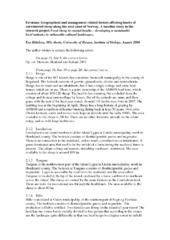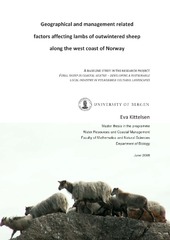| dc.description.abstract | The Ancient Norse breed of outwintered sheep (ANBOS/Feral sheep) are the traditional sheep of Norwegian coastal heathlands, an open semi-natural landscape now threatened by regrowth due to cessation of management. One of the main challenges for the ANBOS industry is the low slaughter weights achieved in some herds, and the aim of my MSc project is to provide a baseline study of the relationships between geographic and management-related variables and the weights of ANBOS lambs in different herds along the Norwegian coast. My study will be crucial for identifying possible causal factors behind the between-population variability in lamb weights, and it provides an important first step towards the aims of the Feral Sheep project, namely to develop efficient farming practices that mitigate the economic and animal welfare problems linked to the poor lamb growth and low weights observed in some herds. The 13 localities included in the study were situated along a 500 km latitudinal gradient on the western coast of Norway. Each locality was grazed by an ANBOS herd. On each site, through land cover mapping, and through interviews with sheep owners, data was compiled that could possibly explain differences in lamb weights. Linear regressions and t-tests were used for the statistical analysis, with the compiled data as predictor variables, and with lamb growth rates and slaughter weights obtained from Bioforsk as explanatory variables. ANBOS lamb weights increased with the percentage of grass on the pastures, and decreased with increasing annual precipitation and discharge. Although there were considerable differences in management practices between herds, no management-related variables were found to be important for lambs growth and weights. Summer fodder is an important compartment of sheep diets, but summer fodder may be sampled and analyzed at different assumptions, and my data indicate that the availability of summer fodder is more important than any other variable for explaining lamb weights. However, lamb weights were collected in the summer season, so in order to be able to explain temporal patterns, the Feral Sheep project should aim at collecting data that enables comparison of winter and summer grazing and habitat use. | en_US |

